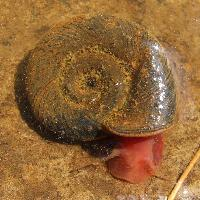
Poids et mesures
| Hauteur au garrot | 13 mm |
|---|---|
| Longueur | 30 mm |
Description de l'animal
The Great Ramshorn, scientifically known as Planorbarius corneus, is a species of air-breathing freshwater snail that belongs to the family Planorbidae, the ram's horn snails. This species is notable for its distinctive shell shape and size, making it a subject of interest among aquarists, naturalists, and researchers alike.Physical Description:
The most striking feature of the Great Ramshorn is its large, coil-shaped shell, which resembles the horn of a ram, hence the name. The shell can reach up to 35-40mm in diameter, making it one of the larger species within its family. The shell coils in a planispiral manner, meaning it lays flat rather than coiling vertically or in a conical shape. This gives the snail a unique, disc-like appearance when viewed from above or below. The color of the shell ranges from light brown to a rich, dark brown, often with subtle variations in hue that create bands or patterns along the whorls.
The body of the Great Ramshorn is soft and muscular, with a color that can vary from a light creamy hue to darker shades of brown or grey, often depending on the snail's diet and environmental conditions. It possesses a broad, triangular head with two tentacles on top, each bearing an eye at its base, which it uses to navigate its surroundings.
Habitat and Distribution:
Planorbarius corneus is primarily found in slow-moving or stagnant freshwater habitats such as ponds, lakes, ditches, and slow-flowing rivers. It prefers environments with abundant vegetation, which provides both food and shelter. This species is widespread across Europe, extending from the British Isles eastward to Russia, and from Scandinavia down to the Mediterranean region. It has also been introduced to other parts of the world, including North America.
Diet and Behavior:
The Great Ramshorn is an omnivorous feeder, subsisting on a diet that includes algae, detritus, dead plant material, and sometimes even dead animal matter. It plays a crucial role in the ecosystem as a scavenger, helping to clean up dead organic matter and control algae growth. The snail uses its radula, a tongue-like organ covered with tiny teeth, to scrape food off surfaces.
Reproduction:
Reproduction in Planorbarius corneus is hermaphroditic, meaning each individual possesses both male and female reproductive organs. However, self-fertilization is rare, and snails typically mate with another individual to exchange sperm. After mating, each snail can lay several batches of eggs, which are deposited on solid surfaces such as rocks, plants, or even the aquarium glass in captive environments. The eggs hatch into miniature versions of the adults after about two weeks, depending on temperature and environmental conditions.
Conservation Status:
The Great Ramshorn is currently not considered to be at risk and is classified as Least Concern by the IUCN. It is common and widespread in its native range. However, like many freshwater species, it could be susceptible to habitat loss, pollution, and changes in water quality, which could impact its populations in the future.
In summary, the Great Ramshorn, Planorbarius corneus, is a fascinating freshwater snail with a distinctive appearance and significant ecological role. Its presence in aquatic ecosystems contributes to the health and balance of these environments, making it an important species for both natural and artificial water bodies.
Nouvelles photos d'animaux
Top 10 des animaux
- Dolphin gull (Leucophaeus scoresbii)
- Japanese macaque (Macaca fuscata)
- Greek tortoise (Testudo graeca)
- Stone loach (Barbatula barbatula)
- Russian tortoise (Testudo horsfieldii)
- Galápagos tortoise (Geochelone nigra complex)
- Diana monkey (Cercopithecus diana)
- Moustached guenon (Cercopithecus cephus)
- Common flying dragon (Draco volans)
- Galápagos penguin (Spheniscus mendiculus)